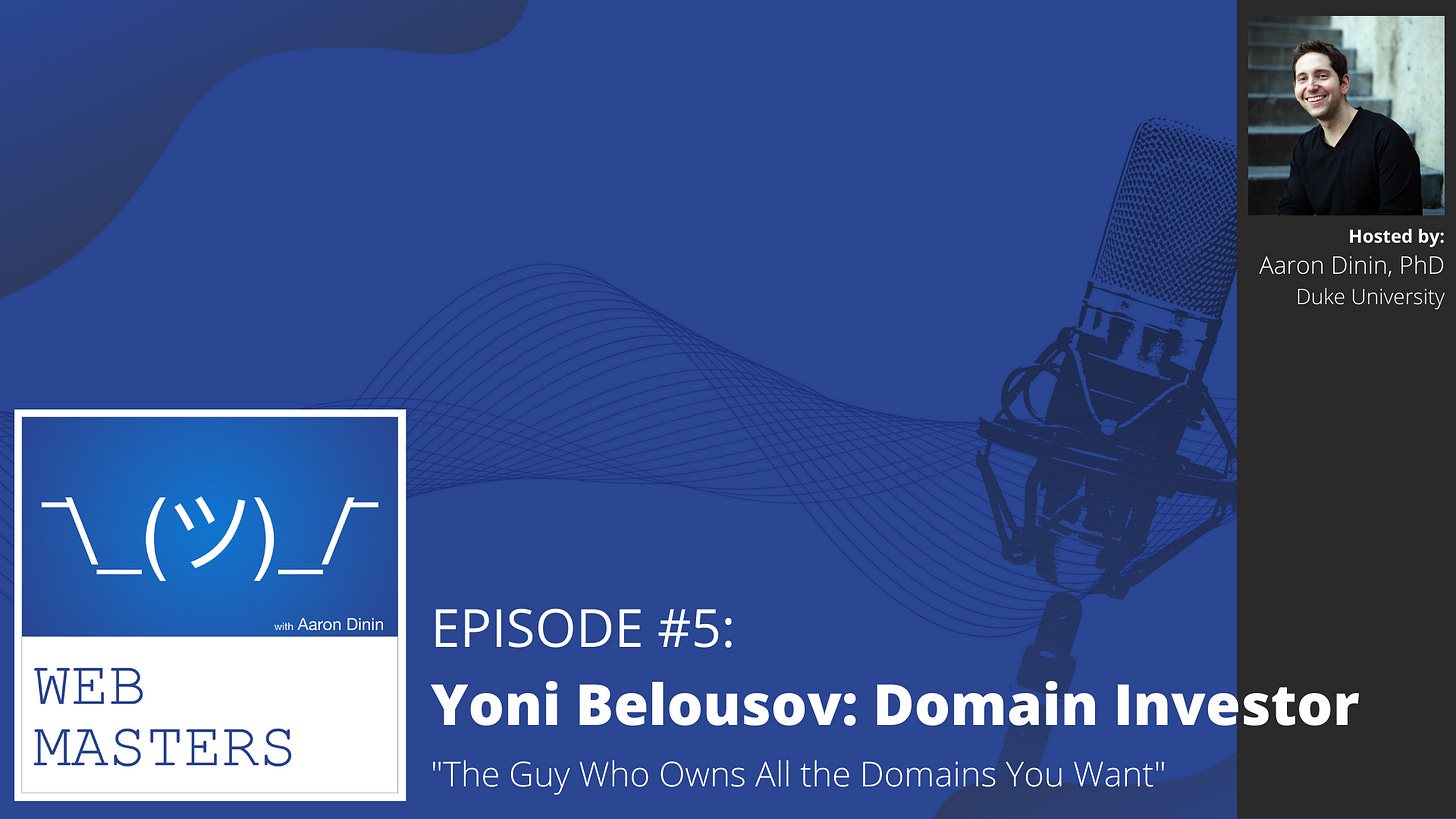Entrepreneur Office Hours - Issue #2
Advice about "new categories," a warning sign you're building the wrong startup, and a conversation with a multi-millionaire domain investor

Made it to Issue #2!
Wow… this entrepreneur office hours idea was admittedly a bit of experiment. I can’t believe how many people signed up after the first issue. Thanks for joining, thanks for reading, and thanks for asking questions!
Below you’ll find the articles I published this week, my latest podcast episode, and, at the end, my Office Hours Q&A based on your startup questions.
If you’ve got other startup questions you’d like answered in the next issue, reply to this email, @me on Twitter, message me on LinkedIn, or whatever else you come up with. If I’ve got a good/useful response, I’ll share it here in EOH.
-Aaron
P.S. If you like these emails, please forward them to others. The bigger our community, the more we can all learn from each other.
Is This a Warning Sign You’re Building the Wrong Startup?

One of the biggest warning signs that your startup isn’t going to be successful is also one of the most subtle. It’s hidden in the way you think about interacting with potential customers. Find out what it is…
Yoni Belousov: The Guy Who Owns All of the Domains You Want

On Web Masters, I got to speak with Yoni Belousov, one of the world’s largest private domain investors. Domain investing is one of the more secretive industries on the Internet, and getting someone like Yoni to open up about it was a real opportunity. Don’t miss his insights on what it takes to successfully buy and sell domains. Find the latest episode on:
…or just search “Web Masters” wherever you listen to your favorite podcasts.
Move Slowly and Fix Things: How to Build World-Changing Startups

Mark Zuckerberg's infamous "Move fast and break things" mantra has become a rallying cry for startups and entrepreneurs everywhere. But it's also completely misunderstood and out of context. Do you know what it was really about and how it can actually help you build a world-changing startup? I explain here…
Office Hours Q&A
———————
QUESTION: Could write a bit on messaging your product when you’re creating a new category? We just launched and we are really wrestling with messaging. After a week of being alive in the world I’m already testing a new message
- Lyle
———————-
ANSWER: This question is dealing with two different issues that are worth considering: Issue #1) operating in a “new category”; and, Issue #2) testing messaging. Let’s start with the new category issue first, then we’ll jump to messaging.
Issue #1: New Categories
Entrepreneurs are inherently enamored with creating new things. Almost by definition, they don’t want to follow in other people’s footsteps. They want to be first… the leader… the best… etc. Those aren’t necessarily bad things (or good things), but, in this case, I promise it’s a terrible way to view what you’re working on.
Honestly, whenever I see/hear entrepreneurs using the phrase “new category” to describe their market, I want to scream “NOOOOOOOOOO! You’re making a huge mistake!” at the top of my lungs. Is it possible to create a new category? Maybe. Is it possible to exist in a new category? Perhaps. But why would you want to do that to yourself? You’re committing yourself to creating an unnecessarily massive amount of work.
Specifically, the work you’re creating for yourself is educational work. By definition, a new market category is something consumers don’t understand. That’s never a good thing because it means before you can ever sell them, you have to teach them about the category. And teaching people takes a long time and costs lots of money. Plus, just because you’ve taught someone, there’s no guarantee they’ll buy from you. (Trust me on this… I spend lots of time teaching people for free with my content, but how many of you reading this are subscribed to my podcast? Hmmmmmm? Is that really too big of an ask?)
In other words, by boxing yourself into the idea that you exist inside of a “new category,” you’re basically committing to teaching first, selling second.
My advice here is to find a way to get yourself out of a new category and into a well defined category/problem space that consumers understand and are already willing to spend money on.
Eventually, as your business grows and you have a large audience, you can begin to create a new category and slowly bring your consumers into it over time. For the record, that’s exactly what companies starting new categories actually do. They never start in a completely new space. They begin somewhere consumers are already familiar with, and then, over time they evolve into the new category.
A great example of a company in the process of creating a new category is Uber. Uber is, ultimately, going to be creating the category of subscription, on-demand transportation. By that I mean, in the future, I expect most of us won’t own our own vehicles. Instead, we’re going to have subscriptions to (presumably self-driving) car services. But that transition can’t happen instantly. Instead, it’s a slow process that began by replacing traditional taxis and, over the course of decades, will gradually segue into all of us just pressing buttons and having a random car pick us up wherever we are. For the record, I can’t wait for this new category to finally mature. I hate driving.
Issue #2: Testing messaging
Not only is it OK that you’re testing new messaging so early in the process, it’s actually a great thing. The perfect message isn’t some blessed string of words that falls from heaven onto the tip of your tongue. It’s something you have to practice constantly and workshop with real potential customers until you find a sales pitch that works.
As you practice that messaging, there are two important things to consider:
You’re not going to find the right messaging instantly. There’s not some magic moment where you’re going to go, “THAT WAS IT!” Always remember that even the “perfect” message is only going to be effective a fraction of the time because close-rates are never 100%. Heck, close rates are never 50%. Your goal isn’t to find something that wins every customer. Your goal is to find the most effective possible messaging that works as often as possible.
Never ask people for feedback on your messaging. I mention this because, in your original question, you gave me some examples, and I’m intentionally ignoring them here. That’s not to be mean. That’s to be helpful. I’m just one person with one random opinion, and not your potential customer. So it doesn’t matter if I think your messaging is good or bad. My feelings about your messaging will distract you. The only thing that matters is whether your messaging is or isn’t effective with customers, so focus on that. Unfortunately, most advisors/mentors/etc. don’t realize this. As a result, when people ask for feedback, they give it. But, again, one person’s opinion doesn’t matter. The only thing that matters is the data from how potential customers actually respond. Ignore everything else!
Got startup questions of your own? Just reply to this email with whatever you want to know, and I’ll do my best to answer!



